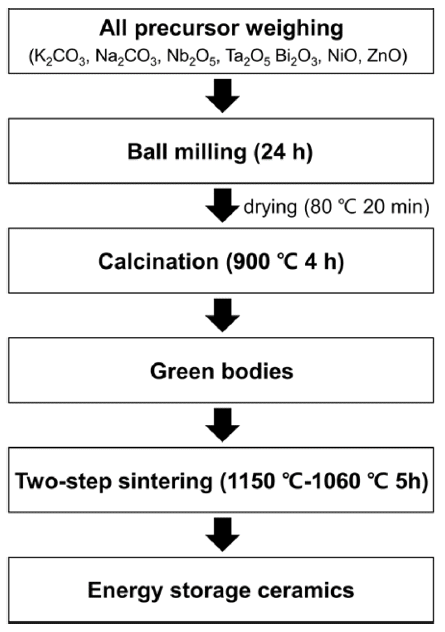Search
- Page Path
- HOME > Search
- Modulation of Microstructure and Energy Storage Performance in (K,Na)NbO3-Bi(Ni,Ta)O3 Ceramics through Zn Doping
- Jueun Kim, Seonhwa Park, Yuho Min
- J Powder Mater. 2023;30(6):509-515. Published online December 1, 2023
- DOI: https://doi.org/10.4150/KPMI.2023.30.6.509

- 273 View
- 11 Download
-
 Abstract
Abstract
 PDF
PDF Lead-free perovskite ceramics, which have excellent energy storage capabilities, are attracting attention owing to their high power density and rapid charge-discharge speed. Given that the energy-storage properties of perovskite ceramic capacitors are significantly improved by doping with various elements, modifying their chemical compositions is a fundamental strategy. This study investigated the effect of Zn doping on the microstructure and energy storage performance of potassium sodium niobate (KNN)-based ceramics. Two types of powders and their corresponding ceramics with compositions of (1-x)(K,Na)NbO3-xBi(Ni2/3Ta1/3)O3 (KNN-BNT) and (1-x)(K,Na)NbO3-xBi(Ni1/3Zn1/3Ta1/3) O3 (KNN-BNZT) were prepared via solid-state reactions. The results indicate that Zn doping retards grain growth, resulting in smaller grain sizes in Zn-doped KNN-BNZT than in KNN-BNT ceramics. Moreover, the Zn-doped KNNBNZT ceramics exhibited superior energy storage density and efficiency across all x values. Notably, 0.9KNN-0.1BNZT ceramics demonstrate an energy storage density and efficiency of 0.24 J/cm3 and 96%, respectively. These ceramics also exhibited excellent temperature and frequency stability. This study provides valuable insights into the design of KNNbased ceramic capacitors with enhanced energy storage capabilities through doping strategies.
- Grain Shape and Grain Growth Behavior in the (K0.5Na0.5)NbO3-CaZrO3 System
- Chul-Lee Lee, Kyoung-Seok Moon
- J Powder Mater. 2022;29(2):110-117. Published online April 1, 2022
- DOI: https://doi.org/10.4150/KPMI.2022.29.2.110

- 155 View
- 0 Download
-
 Abstract
Abstract
 PDF
PDF The grain growth behavior in the (1-x)K0.5Na0.5NbO3-
x CaZrO3 (KNNCZ-x) system is studied as a function of the amount of CZ and grain shape. The (1-x)K0.5Na0.5NbO3-x CaZrO3 (KNNCZ-x) powders are synthesized using a conventional solid-state reaction method. A single orthorhombic phase is observed atx = 0 – 0.03. However, rhombohedral and orthorhombic phases are observed atx = 0.05. The grain growth behavior changes from abnormal grain growth to the suppression of grain growth as the amount of CaZrO3 (CZ) increases. With increasing CZ content, grains become more faceted, and the step-free energy increases. Therefore, the critical growth driving force increases. The grain size distribution broadens with increasing sintering time in KNNCZ-0.05. As a result, some large grains with a driving force larger than the critical driving force for growth exhibit abnormal grain growth behavior during sintering. Therefore, CZ changes the grain growth behavior and microstructure of KNN. Grain growth at the faceted interface of the KNNCZ system occurs via two-dimensional nucleation and growth.
TOP
 kpmi
kpmi

 First
First Prev
Prev


